ESP Citroen GRAND C4 PICASSO 2017 2.G Manual PDF
[x] Cancel search | Manufacturer: CITROEN, Model Year: 2017, Model line: GRAND C4 PICASSO, Model: Citroen GRAND C4 PICASSO 2017 2.GPages: 527, PDF Size: 12.91 MB
Page 282 of 527
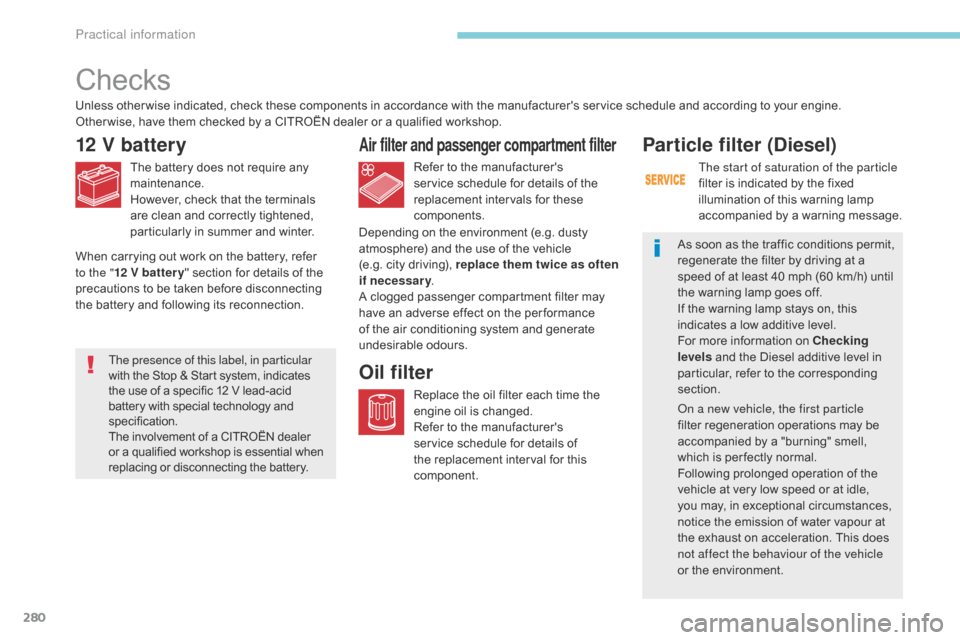
280
C4-Picasso-II_en_Chap07_info-pratiques_ed02-2016
Checks
12 V battery
The battery does not require any
maintenance.
However, check that the terminals
are clean and correctly tightened,
particularly in summer and winter.Refer to the manufacturer's
service schedule for details of the
replacement intervals for these
components.
Air filter and passenger compartment filter
Replace the oil filter each time the
engine oil is changed.
Refer to the manufacturer's
service schedule for details of
the replacement interval for this
component.
Oil filterThe presence of this label, in particular
with the Stop & Start system, indicates
the use of a specific 12 V lead-acid
battery with special technology and
specification.
The involvement of a CITROËN dealer
or a qualified workshop is essential when
replacing or disconnecting the battery.
Unless other wise indicated, check these components in accordance with the manufacturer's service schedule and according to your engine.
Other wise, have them checked by a CITROËN dealer or a qualified workshop.
Depending on the environment (e.g. dusty
atmosphere) and the use of the vehicle
(e.g. city driving), replace them twice as often
if necessary .
A clogged passenger compartment filter may
have an adverse effect on the per formance
of the air conditioning system and generate
undesirable odours.
Particle filter (Diesel)
The start of saturation of the particle
filter is indicated by the fixed
illumination of this warning lamp
accompanied by a warning message.
As soon as the traffic conditions permit,
regenerate the filter by driving at a
speed of at least 40 mph (60 km/h) until
the warning lamp goes off.
If the warning lamp stays on, this
indicates a low additive level.
For more information on Checking
levels and the Diesel additive level in
particular, refer to the corresponding
section.
On a new vehicle, the first particle
filter regeneration operations may be
accompanied by a "burning" smell,
which is per fectly normal.
Following prolonged operation of the
vehicle at very low speed or at idle,
you may, in exceptional circumstances,
notice the emission of water vapour at
the exhaust on acceleration. This does
not affect the behaviour of the vehicle
or the environment.
When carrying out work on the battery, refer
to the "
12 V batter y " section for details of the
precautions to be taken before disconnecting
the battery and following its reconnection.
Practical information
Page 284 of 527
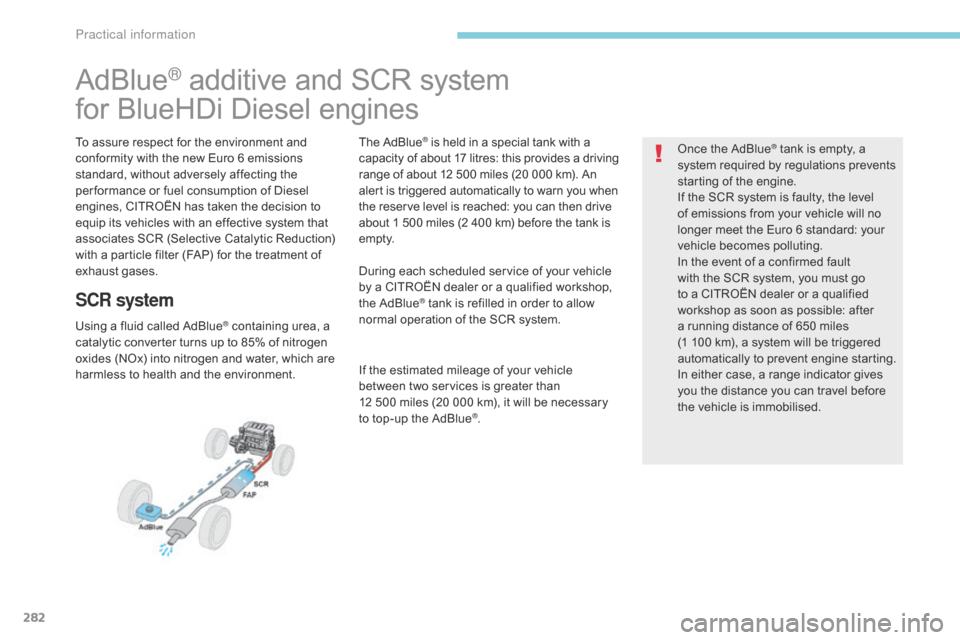
282
C4-Picasso-II_en_Chap07_info-pratiques_ed02-2016
AdBlue® additive and SCR system
for BlueHDi Diesel engines
To assure respect for the environment and
conformity with the new Euro 6 emissions
standard, without adversely affecting the
per formance or fuel consumption of Diesel
engines, CITROËN has taken the decision to
equip its vehicles with an effective system that
associates SCR (Selective Catalytic Reduction)
with a particle filter (FAP) for the treatment of
exhaust gases.
SCR system
Using a fluid called AdBlue® containing urea, a
catalytic converter turns up to 85% of nitrogen
oxides (NOx) into nitrogen and water, which are
harmless to health and the environment. The AdBlue
® is held in a special tank with a
capacity of about 17 litres: this provides a driving
range of about 12 500 miles (20 000 km). An
alert is triggered automatically to warn you when
the reserve level is reached: you can then drive
about 1 500 miles (2 400 km) before the tank is
e m pt y.
During each scheduled service of your vehicle
by a CITROËN dealer or a qualified workshop,
the AdBlue
® tank is refilled in order to allow
normal operation of the SCR system.
If the estimated mileage of your vehicle
between two services is greater than
12 500 miles (20 000 km), it will be necessary
to top-up the AdBlue
®. Once the AdBlue
® tank is empty, a
s
ystem required by regulations prevents
starting of the engine.
If the SCR
system is faulty, the level
of emissions from your vehicle will no
longer meet the Euro 6 standard: your
vehicle becomes polluting.
In the event of a confirmed fault
with the SCR system, you must go
to a CITROËN dealer or a qualified
workshop as soon as possible: after
a running distance of 650 miles
(1
100 km), a system will be triggered
automatically to prevent engine starting.
In either case, a range indicator gives
you the distance you can travel before
the vehicle is immobilised.
Practical information
Page 289 of 527

287
C4-Picasso-II_en_Chap08_en-cas-panne_ed02-2016
This kit is installed in the storage box, under the
boot floor.This kit consists of a compressor and a sealant cartridge.
It allows the temporary repair
of a tyre.
You are then able to go to the nearest garage.
It is designed to repair most punctures which could affect the tyre, located on the tyre tread or
shoulder.
Its compressor can be used to check and adjust the pressure of the tyre.
Temporary puncture repair kit
Access to the kit
Depending on version, the kit is stowed under
the front passenger's seat or in the storage box
under the second row footwell.
List of tools
* Depending on equipment. All of these tools are specific to your vehicle
and can vary depending on equipment. Do not
use them for other purposes.
1.
1
2 V compressor.
C
ontains a sealant cartridge for the
temporary repair of a tyre and can also be
used for adjusting tyre pressures.
2.
C
hocks* to immobilise the wheels of the
vehicle.
3.
W
heel bolt cover remover*.
F
or removing the wheel bolt covers on alloy
wheels.
4.
R
emovable towing eye and front protective
cover opening tool.
For more information on To w i n g , refer to the
corresponding section.
8
In the event of a breakdown
Page 292 of 527
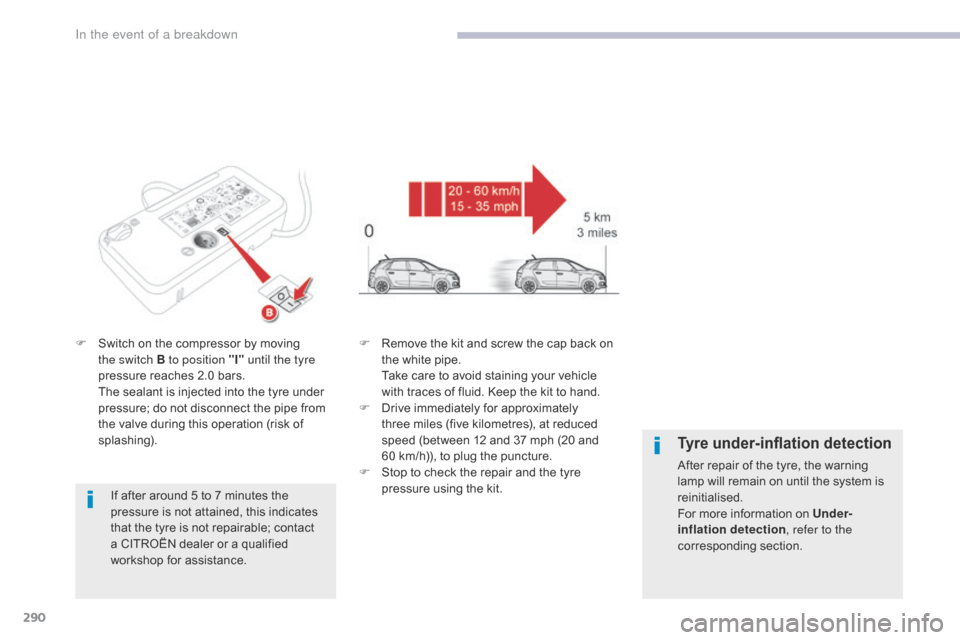
290
C4-Picasso-II_en_Chap08_en-cas-panne_ed02-2016
F Switch on the compressor by moving the switch B to position "I" until the tyre
pressure reaches 2.0 bars.
T
he sealant is injected into the tyre under
pressure; do not disconnect the pipe from
the valve during this operation (risk of
splashing).
If after around 5 to 7 minutes the
pressure is not attained, this indicates
that the tyre is not repairable; contact
a CITROËN dealer or a qualified
workshop for assistance. F
R emove the kit and screw the cap back on
the white pipe.
T
ake care to avoid staining your vehicle
with traces of fluid. Keep the kit to hand.
F
D
rive immediately for approximately
three miles (five kilometres), at reduced
speed (between 12 and 37 mph (20 and
60
km/h)), to plug the puncture.
F
S
top to check the repair and the tyre
pressure using the kit.
Tyre under-inflation detection
After repair of the tyre, the warning
lamp will remain on until the system is
reinitialised.
For more information on Under-
inflation detection , refer to the
corresponding section.
In the event of a breakdown
Page 295 of 527
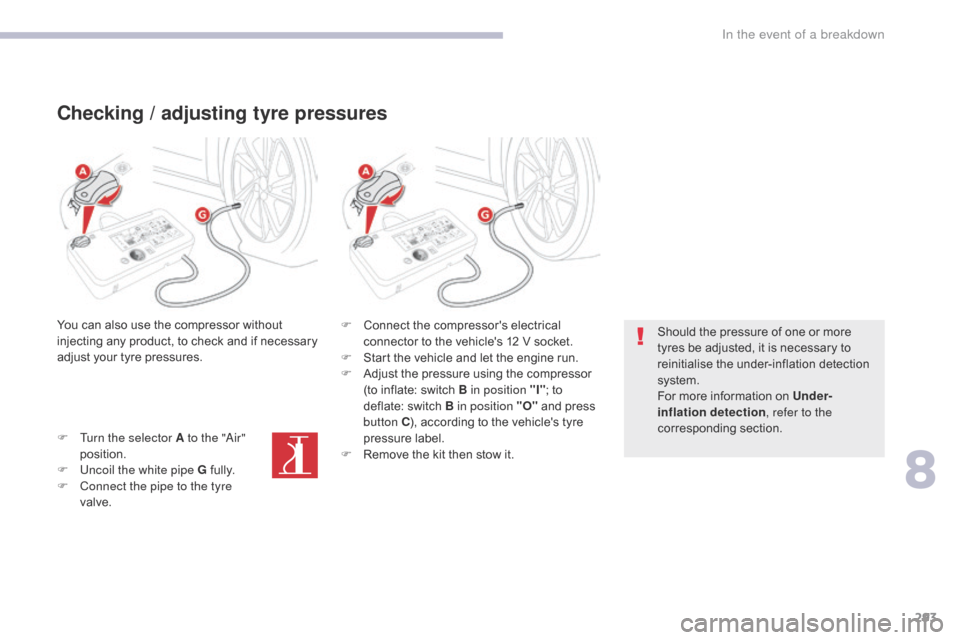
293
C4-Picasso-II_en_Chap08_en-cas-panne_ed02-2016
Checking / adjusting tyre pressures
You can also use the compressor without
injecting any product, to check and if necessary
adjust your tyre pressures.
F
T
urn the selector A to the "Air"
position.
F
U
ncoil the white pipe G fully.
F
C
onnect the pipe to the tyre
valve. F
C onnect the compressor's electrical
connector to the vehicle's 12 V socket.
F
S
tart the vehicle and let the engine run.
F
A
djust the pressure using the compressor
(to inflate: switch B in position "I" ; to
deflate: switch B in position "O" and press
button C ), according to the vehicle's tyre
pressure label.
F
R
emove the kit then stow it.Should the pressure of one or more
tyres be adjusted, it is necessary to
reinitialise the under-inflation detection
system.
For more information on Under-
inflation detection
, refer to the
corresponding section.
8
In the event of a breakdown
Page 296 of 527

294
C4-Picasso-II_en_Chap08_en-cas-panne_ed02-2016
Spare wheel
The tools are installed in the boot under the
f l o o r.
Remove the boot carpet for access to them.
Access to the tools
List of tools*
Procedure for changing a wheel with a punctured tyre for the spare wheel using the tools provided with the vehicle.All of these tools are specific to your
vehicle and can vary according to the level
of equipment. Do not use them for other
purposes.
1.
W
heelbrace.
F
or removing the wheel trim and removing
the wheel bolts.
2.
C
hock for immobilising the vehicle (except
versions with manual gearbox).
3.
J
ack with integral handle.
F
or raising the vehicle.
4.
W
heel bolt cover remover.
F
or removing the wheel bolt covers on alloy
wheels.
5.
S
ocket for the security bolts (located in the
glove box).
F
or adapting the wheelbrace to the special
"security" bolts.
6.
T
owing eye and front protective cover
opening tool.
For more information about To w i n g , refer to
the corresponding section.
* Depending on equipment.
In the event of a breakdown
Page 298 of 527
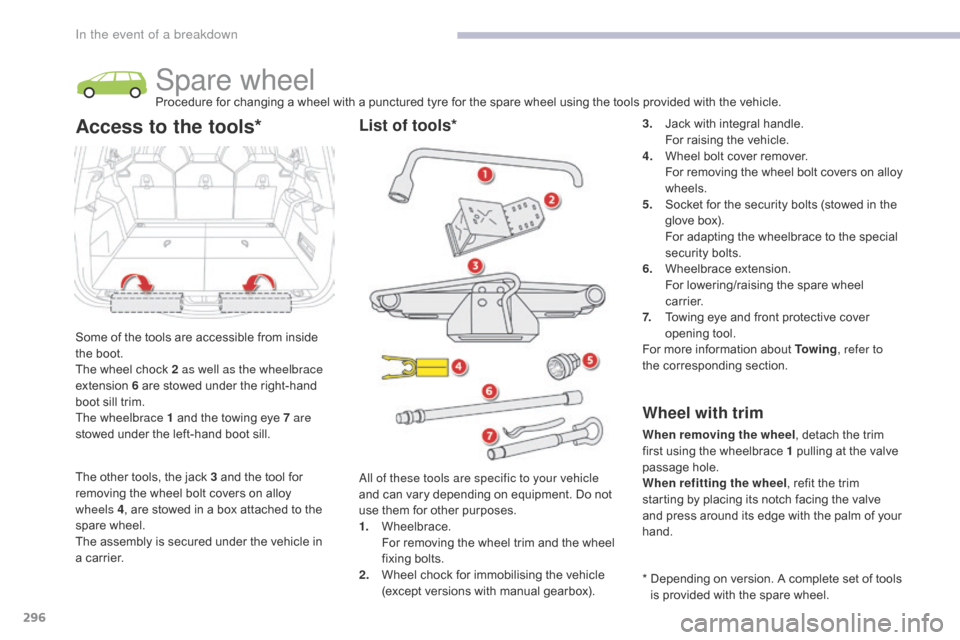
296
C4-Picasso-II_en_Chap08_en-cas-panne_ed02-2016
Spare wheelProcedure for changing a wheel with a punctured tyre for the spare wheel using the tools provided with the vehicle.
Some of the tools are accessible from inside
the boot.
The wheel chock 2 as well as the wheelbrace
extension 6 are stowed under the right-hand
boot sill trim.
The wheelbrace 1 and the towing eye 7 are
stowed under the left-hand boot sill.
Access to the tools*3. Jack with integral handle. F or raising the vehicle.
4.
W
heel bolt cover remover.
F
or removing the wheel bolt covers on alloy
wheels.
5.
S
ocket for the security bolts (stowed in the
glove box).
F
or adapting the wheelbrace to the special
security bolts.
6.
W
heelbrace extension.
F
or lowering/raising the spare wheel
c a r r i e r.
7.
T
owing eye and front protective cover
opening tool.
For more information about To w i n g , refer to
the corresponding section.
Wheel with trim
When removing the wheel , detach the trim
first using the wheelbrace 1 pulling at the valve
passage hole.
When refitting the wheel , refit the trim
starting by placing its notch facing the valve
and press around its edge with the palm of your
hand.
All of these tools are specific to your vehicle
and can vary depending on equipment. Do not
use them for other purposes.
1.
W
heelbrace.
F
or removing the wheel trim and the wheel
fixing bolts.
2.
W
heel chock for immobilising the vehicle
(except versions with manual gearbox). *
D
epending on version. A complete set of tools
is provided with the spare wheel.
The other tools, the jack 3 and the tool for
removing the wheel bolt covers on alloy
wheels
4 , are stowed in a box attached to the
spare wheel.
The assembly is secured under the vehicle in
a carrier.
List of tools*
In the event of a breakdown
Page 300 of 527

298
C4-Picasso-II_en_Chap08_en-cas-panne_ed02-2016
A punctured wheel from the vehicle
cannot be fitted under the vehicle. It
must be carried in the boot. Use a cover
to protect the boot.
F
P
ress the tongue, slide the tool box cover
to the centre and remove it for access to
the other tools ( jack and wheel bolt cover
remover for alloy wheels).
Putting the carrier and spare
wheel back in place
F Stow the corresponding tools in the box and close the cover.
F
P
osition the tool box on the ground.
Stowing the tools
F Return the tools to the box and stow the box in the vehicle's boot.
F
W
ind in the carrier by turning the
wheelbrace clockwise: once the cable is
fully wound in you should no longer feel
any resistance.
F
S
tow the other tools in the locations
provided in the boot.
When the spare wheel is fitted in place
of a punctured wheel, it is essential
to return the carrier and tools to their
normal position under the vehicle
before moving off.
In the event of a breakdown
Page 316 of 527
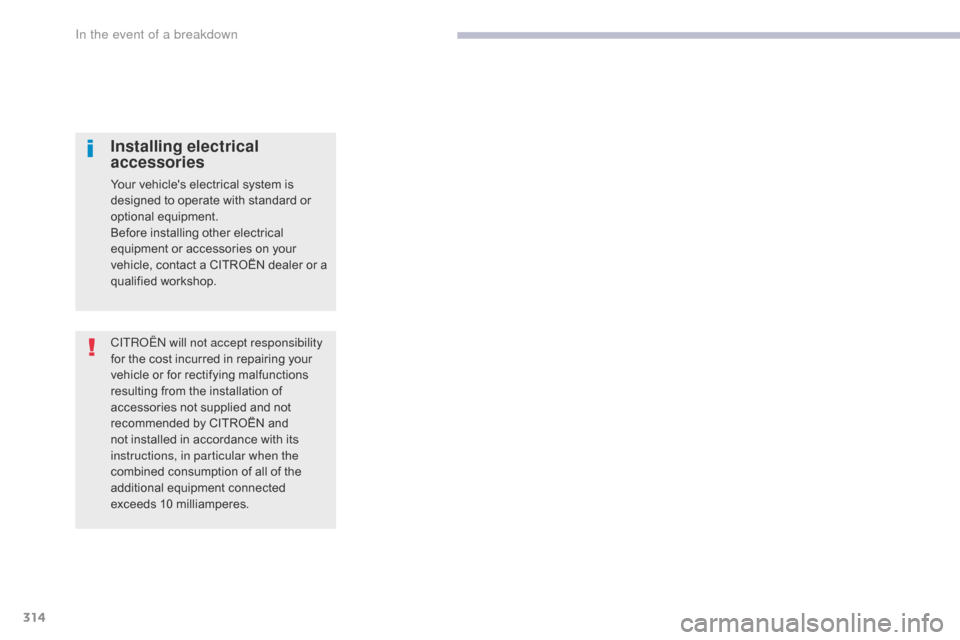
314
C4-Picasso-II_en_Chap08_en-cas-panne_ed02-2016
CITROËN will not accept responsibility
for the cost incurred in repairing your
vehicle or for rectifying malfunctions
resulting from the installation of
accessories not supplied and not
recommended by CITROËN and
not installed in accordance with its
instructions, in particular when the
combined consumption of all of the
additional equipment connected
exceeds 10 milliamperes.
Installing electrical
accessories
Your vehicle's electrical system is
designed to operate with standard or
optional equipment.
Before installing other electrical
equipment or accessories on your
vehicle, contact a CITROËN dealer or a
qualified workshop.
In the event of a breakdown
Page 323 of 527
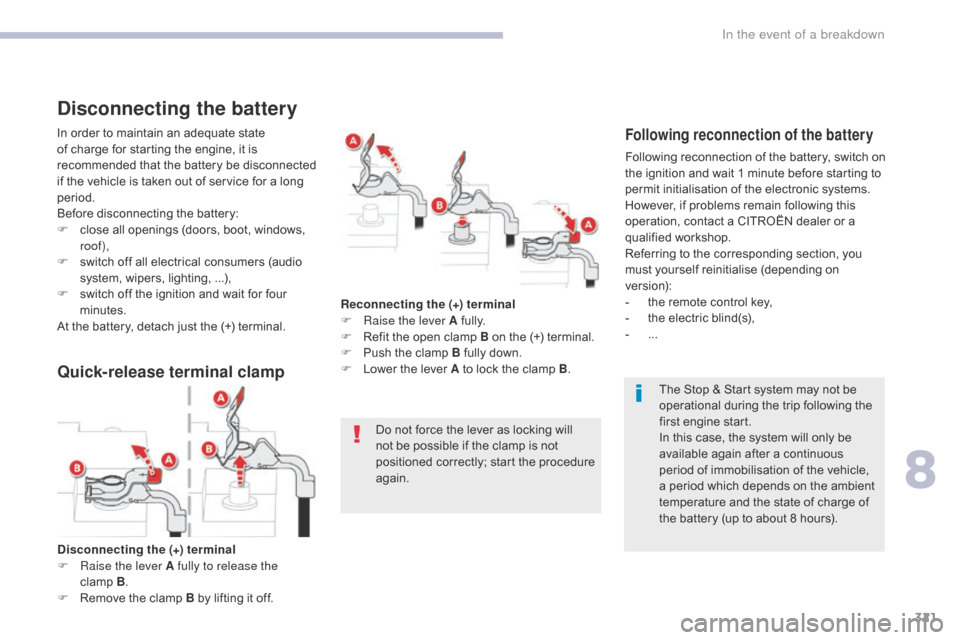
321
C4-Picasso-II_en_Chap08_en-cas-panne_ed02-2016
The Stop & Start system may not be
operational during the trip following the
first engine start.
In this case, the system will only be
available again after a continuous
period of immobilisation of the vehicle,
a period which depends on the ambient
temperature and the state of charge of
the battery (up to about 8 hours).
Do not force the lever as locking will
not be possible if the clamp is not
positioned correctly; start the procedure
again.
Disconnecting the (+) terminal
F
Ra
ise the lever A fully to release the
clamp
B .
F
R
emove the clamp B by lifting it off. Reconnecting the (+) terminal
F
Ra
ise the lever A fully.
F
R
efit the open clamp B on the (+) terminal.
F
P
ush the clamp B fully down.
F
L
ower the lever A to lock the clamp B
.
Disconnecting the battery
In order to maintain an adequate state
of charge for starting the engine, it is
recommended that the battery be disconnected
if the vehicle is taken out of service for a long
period.
Before disconnecting the battery:
F
c
lose all openings (doors, boot, windows,
roof),
F
s
witch off all electrical consumers (audio
system, wipers, lighting,
...),
F
s
witch off the ignition and wait for four
minutes.
At the battery, detach just the (+) terminal.Following reconnection of the battery
Following reconnection of the battery, switch on
the ignition and wait 1 minute before starting to
permit initialisation of the electronic systems.
However, if problems remain following this
operation, contact a CITROËN dealer or a
qualified workshop.
Referring to the corresponding section, you
must yourself reinitialise (depending on
version):
-
t
he remote control key,
-
t
he electric blind(s),
-
...
Quick-release terminal clamp
8
In the event of a breakdown